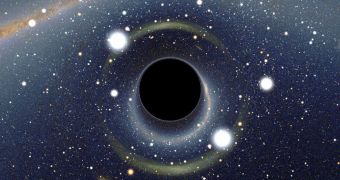An exciting new theory from researchers in the United States proposes that the earliest supermassive black holes to develop in the early Universe were produced the the collapse of immense, dark matter stars. The phenomenon may have been very widespread across the young Cosmos.
The concept of a dark star is not new, but thus far astronomers have found no evidence that such objects exist. Truth be told, they never even discovered evidence that dark matter itself exists.
However, postulating that both exist, and that the current leading theory on how dark matter looks like and behaves is also true, the new proposal makes a lot of sense, experts say. It basically points at a new formation mechanism for the formation of supermassive black holes.
This new idea was proposed by the associate director of the University of Michigan Center for Theoretical Physics, Katherine Freese. She says that, when stars develop, the primary source of energy within the objects is dark matter heating up, and not nuclear fusions as previously believed.
In other words, the annihilation of weakly interacting massive particles (WIMP) – thought to be that main component of dark matter – is providing the heat that eventually leads to the ignition of stars.
Over millions of years, Freese explains, the dark matter fuel contained in the stars gets depleted, as all WIMP interact with and annihilate each other. These particles are their own antiparticles, experts say.
When the fuel is exhausted, the stellar object turns into a heavy main sequence star, which then goes on to collapse into a supermassive black hole at the end of its burning cycle, after it goes supernova.
However, in order for this idea to be true, a lot of things have to come together. For starters, experts need to prove that dark matter exists, and that it was able to form the vast majority of stars' material when the objects first appeared.
At the same time, if dark matter is not discovered, then the way galaxies behave, and the gravitational pull they exert on surrounding objects would make no sense. Astronomers say that galaxies are a lot heavier than accounted for by their visible, measurable mass alone.
This led experts to develop the concept of dark matter. The stuff only interacts with normal (baryonic) matter through the force of gravity, the theory goes, It is estimated that dark matter makes up about 23 percent of the mass of the Universe, whereas visible matter only accounts for about 4 percent.
Experts now hope that an upcoming NASA mission, the James Webb Space Telescope, will help them determine whether dark matter indeed played a role in forming the earliest stars. This observatory will be able to see very far back in the history of the Universe, Daily Galaxy reports.

 14 DAY TRIAL //
14 DAY TRIAL //